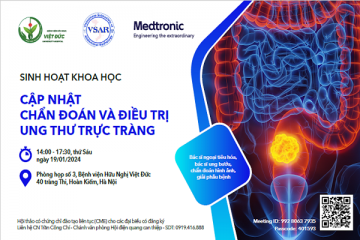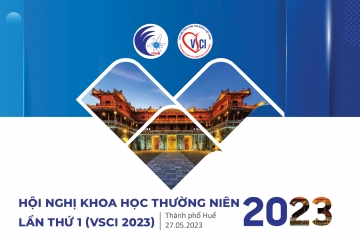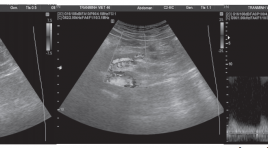
Bóc tách động mạch mạc treo tràng trên đơn độc chẩn đoán và điều trị
01/04/2020 14:15:33 | 0 binh luận
SUMMARRY Isolated superior mesenteric artery (SMA) dissection, with no other abnormality or aortic dissection, is unusual. Diagnosis base on the aid of Doppler and 64-slice multidetector CT. We report two cases of isolated spontaneous SMA dissection without aortic involvement in two patients who had presented with epigastric pain that was especially worse after food intake. Examen on 64-slice multidetector CT show an isolated SMA dissection, not involving the aorta. These patients were managed conservatively with anticoagulants. Keyword: Isolated superior mesenteric artery.

Điều trị dị dạng động tĩnh mạch thận bẩm sinh bằng can thiệp nội mạch
01/04/2020 11:38:23 | 0 binh luận
Transarterial embolization in management of congenital renal arteriovenous malformation SUMMARY Objective: To evaluate the safety and efficacy of transarterial embolization (TAE) in management of congential renal arteriovenous malformation (AVM). Patients and Methods: Between December 2007 and June 2015, 11 patients with congential renal AVM treated with TAE was investigated for clinical presentation, imagine features, treatment methods and complications in Viet Duc hospital. Results: 11 patients (9 women/2 men) with 10/11 gross hematuria, 5/11 flank pain and 1/11 hypertension underwent 11 sessions of treatment, TAE was performed with histoacryl + lipiodol in 7 patients, micro-coils in 3 patients, absolute alcohol and histoacryl in 1 patient. Technical and clinical success were obtained in all patients. There was only 1 patient with fever, renal function was normal in all patient pre - embolization and post - embolization. Conclusion: TAE treatment was safe and effective, it should be recommended as the first choice to treat congential renal AVM. Key word : renal arteriovenous malformation, embolization.
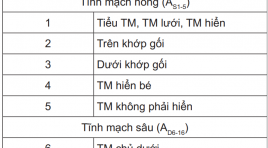
Hệ thống xếp loại C.E.A.P cho các rối loạn tĩnh mạch mạn tính và vai trò của siêu âm doppler
01/04/2020 10:00:07 | 0 binh luận
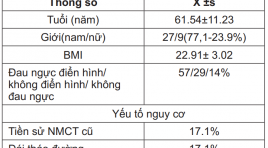
Bước đầu áp dụng cộng hưởng từ tim trong chẩn đoán bệnh tim thiếu máu cục bộ mãn tính
31/03/2020 19:35:01 | 0 binh luận
Cardiac Magnetic Resonance Imaging in diagnose Ischemia Heart Disease SUMMARY Objective : Accuracy of Cardiac Magnetic Resonance in diagnose ischemia heart disease with patients suspected coronary artery disease (CAD) in comparison to invasive angiography. Material and Methods: Thirty-five patients (61.54±11.23 years, 27 men, 71.4% CAD) underwent CMR including cine, short axis to evaluate EF, EDV, ESV, stress PERF (adenosine 140 μg/ min/kg), rest PERF (SSFP, 3 short axis, 1 saturation prepulse per slice) and LGE (3D inversion recovery technique) using Gd- BOPTA. Images were analyzed visually. Stenosis >50% in invasive angiography was considered significant. Results : Mean study time was: 41.37±11.04 minutes, EF: 48.95±18.55%, Hypokinesia: 57.1%, Akinesia: 17.1%. Sensitivity for PERF, LGE and the combination of PERF/LGE was 100%, 82.4%, 100%, respectively and specificity 80%, 80%, 80%, respectively. PPV: 94.4%, 93.3%, 94.4%, NPV: 100%, 57.1%, 100%. A good relation (p<0.01) between deficit perfusion state, the levels of myocardial delayed enhancement correlation with coronary stenosis of LAD, RCA, LCx. Conclusion: In patients with CAD, the combination of stress PERF, LGE is feasible. A combined perfusion and infarction CMR examination with can diagnose CAD in the clinical setting. The combination is superior to perfusion-CMR alone. Key words : Cardiac Magnetic Resonance(CMR), diagnose, ischemia heart disease (IHD), coronary artery, late gadolinium, perfusion.

Hiệu quả điều trị can thiệp nội mạch tổn thương động mạch thận do chấn thương
31/03/2020 19:14:13 | 0 binh luận
The efficacy embolization in treatment of renal arterial trauma SUMMARY Pupose: to apply and estimate the efficacy of embolization in renal injury. Material and method: 26 patients were undergone renal angiography and embolization at Viet Duc hospital from 1/2010 to 8/2013. Among those patients, 23 cases showed pseudoaneurysm, 2 cases showed extravasation and 1 case showed AVM on CT scan. Result: All patients who underwent embolization did not show extravasation (100%) and ongoing hemorrhage required laparotomy on angiography postoperative. Conclusion : In hemodynamically stable and controlled patients, selective and superselective embolization is a safe and effective method for the management of renal vascular injury. Keyword: : Embolization- Aneurysm- Arterial injuries- Arteriography- Renal trauma- Arteriovenous fistula- Angiography- Extravasation- Arterial bleeding.
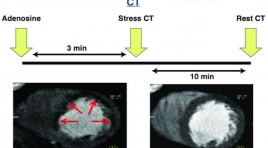
Nghiên cứu bước đầu vai trò của chụp cắt lớp vi tính 320 dãy trong đánh giá tưới máu cơ tim
17/03/2020 10:24:49 | 0 binh luận
An initial study on the role of 320 detector row CT in Myocardial Perfusion evaluation SUMMARY Objective: To study the role of 320 detector row CT in myocardial perfusion evaluation . Material and Methods: A prospective and descriptive study was carried out on 12 patient with moderate or highly moderate risk of coronary artery diseases from December 2018 to May 2019 at Central Military Hospital 108. Results: 10 male and 2 female, the average age was 63,2. 91.7% of the patients had myocardial ischemia with tranmural perfusion ratio (TPR) ≤ 0,99. The number of coronary arteries had perfusion abnormalities accounted for 38.9%. The diagnostic accuracy increased after perfusion analysis with sensitivity from 83.3% to 91.7% and specificity from 75.0% to 91.7%.\ Conclusion: 320 detector row CT is an effective method to perform both coronary CT angiography and CT perfusion imaging in the same examination . Now we are continuing to collect and study on more patients. Keywords: Myocardial perfusion, tranmural perfusion ratio, computed tomography.
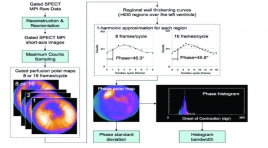
Nghiên cứu tình trạng rối loạn đồng bộ thất trái bằng xạ hình SPECT ở bệnh nhân sau nhồi máu cơ tim
17/03/2020 10:55:19 | 0 binh luận
Assessment of left ventricular dyssynchrony by SPECT myocardial perfusion imaging in post myocardial infartion patients SUMMARY Objective: to evaluate left ventricular synchrony parameters using gated myocardial perfusion single photon emission computed tomography (GSPECT) in post myocardial infarction (MI) patients. Subject and methods: a cross - sectional study was conducted on 34 subjects without cardiovascular disease and 104 post-MI patients. Results : left ventricular dyssynchrony parameters including PSD and HBW were 48.7 ± 19.49 and 154.95 ± 71.97 in post-MI group compared to 17.5 ± 7.24 and 53.9 ± 15.14 respectively in control group (p<0.01). 77% and 81% of post-MI patients had increased PSD and HBW with left ventricular dyssynchrony. PSD and HBW has increased significantly in post-MI patients with NYHA III-V, low EF compared to NYHA I-II patient group without left ventricular dysfunction. Conclusion : left ventricular dyssynchrony parameters were commonly detected by gated SPECT in post-MI patients. PSD and HBW increased significantly in post-MI patients and had relationships to NYHA and left ventricular dysfunction. Keyword: myocardial perfusion imaging, left ventricular dyssynchrony, myocardial infarction.
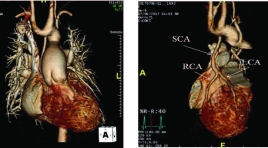
Động mạch vành độc nhất: phân loại và ý nghĩa lâm sàng
18/12/2019 09:41:22 | 0 binh luận
Single coronary artery: classification and clinical significance SUMMARY Objectives: To evaluate ratio and classification single coronary artery in the MSCT cardiac. Material and Methods: Prospective study of 9,868 patients who had scanner MSCT cardiac in Ha Noi Heart Hospital from February, 2015 to September, 2017. Results: The study included 9,868 patients, 43 patients (0,44%) had single coronary artery. 11/43 patients (25,6%) had single coronary artery were isolated. 32/43 patients (74,4%) associated had congenital heart diseases other: 7 patients had Fallot 4, 3 patients had truncus arteriosus, 2 patients had pulmonary atresia, 1 patient had double outlet right ventricle, 1 patient had double discordance and 18 patients had complex congenital heart diseases. Included 43 patients had single coronary artery: 16/43 patients ( 37%) in the type R, 25/43 patients (58%) in the type L and 2/43 patients (5%) not in the current classification who had singler coronary artery high takeoff from truncus brachiocephalic artery. Type L I was 5%, type L II – A: 21%, type L II – B: 18%, type L II – P: 14%, type R II – A: 18%, type R II – B: 12%, type R II – P: 5% and type R III: 2%. Conclusions: Singler coronary artery is a rare congenital anomaly. MDCT cardiac is a non-invasive technique, reliable, that provides accurate information about coronary artery anatomy well as other complex congenital heart diseases. Single coronary artery is a great challenge for surgery to repair the entire congenital heart disease that accompanies it. Keyword : Coronary artery anomalies, Single coronary artery, Coronary angiography, Congenital heart, Surgery congenital heart.
Bạn Đọc Quan tâm
Sự kiện sắp diễn ra
Thông tin đào tạo
- Những cạm bẫy trong CĐHA vú và vai trò của trí tuệ nhân tạo
- Hội thảo trực tuyến "Cắt lớp vi tính đếm Photon: từ lý thuyết tới thực tiễn lâm sàng”
- CHƯƠNG TRÌNH ĐÀO TẠO LIÊN TỤC VỀ HÌNH ẢNH HỌC THẦN KINH: BÀI 3: U não trong trục
- Danh sách học viên đạt chứng chỉ CME khóa học "Cập nhật RSNA 2021: Công nghệ mới trong Kỷ nguyên mới"
- Danh sách học viên đạt chứng chỉ CME khóa học "Đánh giá chức năng thất phải trên siêu âm đánh dấu mô cơ tim"









